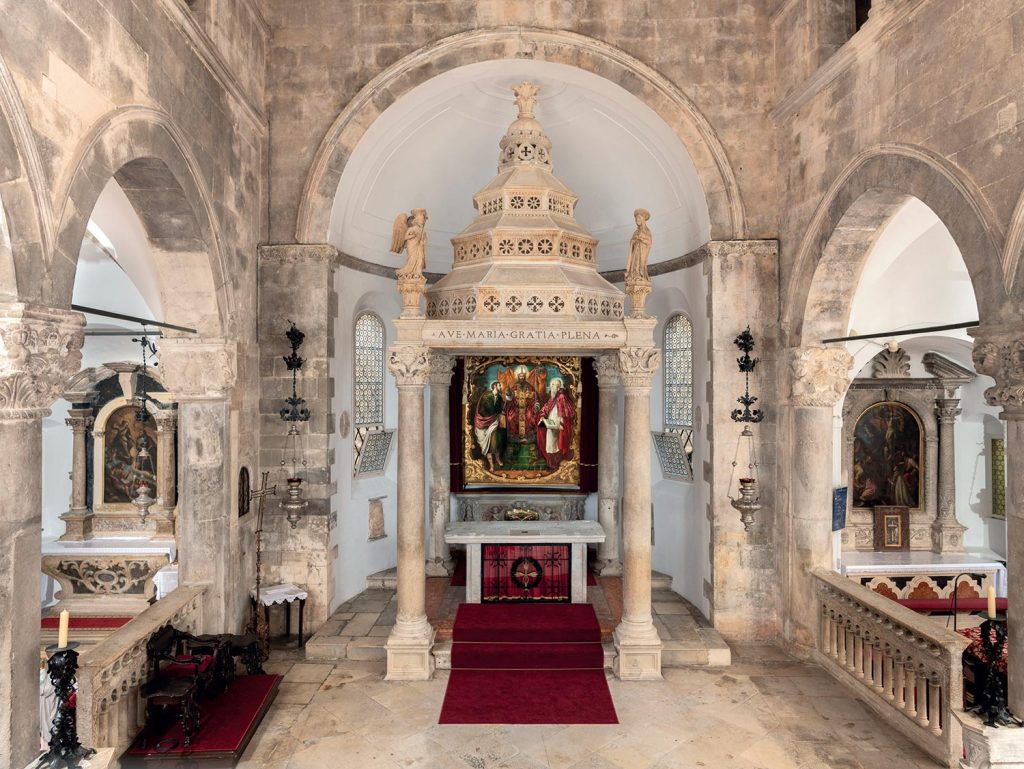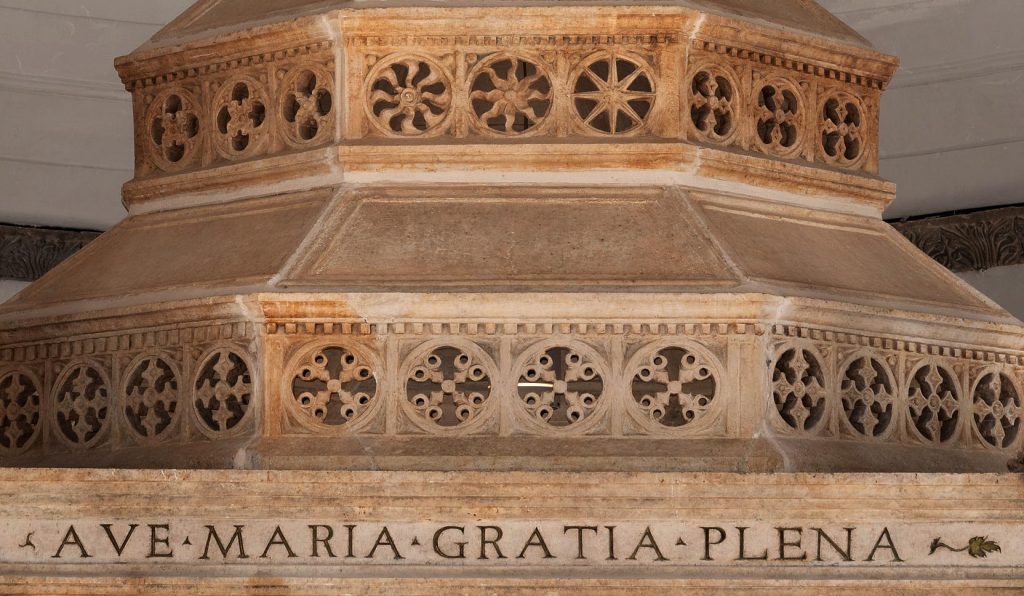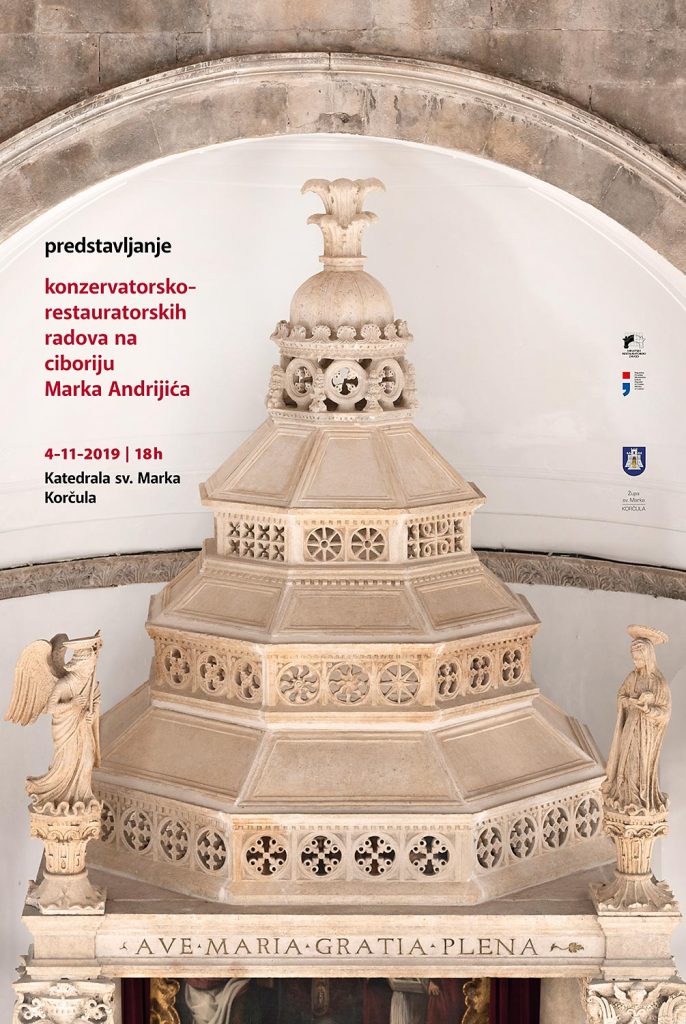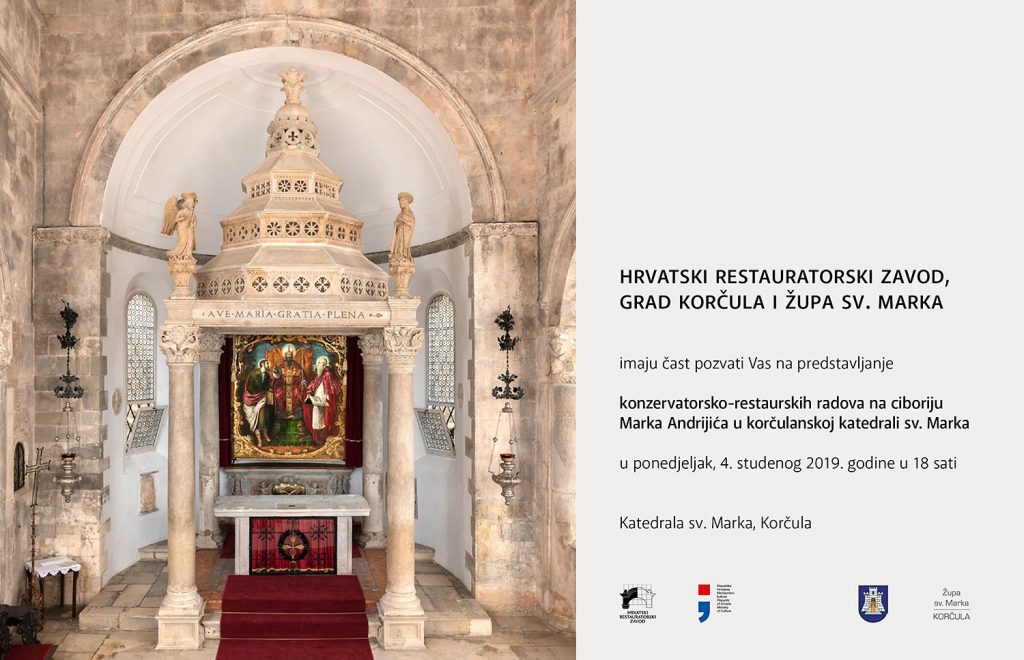The Restoration of Marko Andrijić’ Ciborium in St. Mark’s Cathedral, Korcula
The cathedral of St. Mark’s is located within the walls of the town of Korčula, made out of stone extracted from nearby quarries (locally called ‘petrali’) and built over several centuries through architectural knowledge and stonemasons’ skills of many masters:
“…several stone-carving generations worked and each left signs of their time. The first generations gave, at the beginning of the 15th century, when Romanesque traditions were still present, Romanesque strength and stability in construction, the second generation in mid-15th century adorned it with stone decor, which was solid and mathematically calculated at the base of the building, and flamboyant and free at the top. The third generation with Andrijić at the helm, at the end of the 15th century, brought the purity of a new style – Renaissance, to the cathedral, and the fifth-generation could only bring the exuberance of Baroque into the cathedral during repairs, but only in detail.” (C. Fisković)

In 1300, the church of St. Mark became the seat of the newly established Korčula-Ston Diocese, but little is known about its appearance before 1406. It took several decades to build the new church building, and it was not consecrated until 1556. During this time, the most prominent among the masters were Bonino da Milano, Jacopo Correr and Marko Andrijić, who became protomagister of all public works in Korčula in 1485.
In 1486, in addition to other works in the cathedral, M. Andrijić committed to create a ciborium for 115 ducats. The Apulian-Dalmatian type of ciborium (built using only stone from Vrnik) consists of four slender columns that carry an octagonal roof with several storeys that narrow towards the top and turns into a hollowed tholobate with a spherical dome. In addition to innovations in the constructive solution of a combination of two proportional systems, Andrijić’s work is also recognisable for its stone decor: from the first pillars with entasis of Renaissance to the dolphin capitals, which became the trademark of Andrijić’s bottega.

A series of renovations were carried out on the cathedral at the end of the 18th century, during Bishop Josip Kosirić, changing its original appearance.
Work was also carried out on the ciborium. The last, fourth storey was removed, and instead, four stone slabs carved in the shape of a three-sided leaf were installed. The slabs were connected at the top on which the original acroterium was placed.
This intervention degraded Andrijić’s masterful work. For a time, the original crown was used as a baptismal font in the chapel of St. Roch until it was deposited in the Lapidarium of the Bishop’s Treasury.
In 2014, employees of the Split Department for Conservation, Croatian Conservation Institute, conducted laboratory analyses and cleaning tests, and a drawing of the current condition of the ciborium was made.
Popular Routes: Split to Korcula, Korcula to Split, Dubrovnik to Korcula, Korcula to Dubrovnik
In 2015, the removal of impurities and cement joint reinforcement began. Only after this phase was finished did it become possible to review the condition of the structure. When structural engineers examined the ciborium, and with the consent of conservators (Conservation Department in Dubrovnik), it was agreed to remove the upper, unstable part of the ciborium and transport it to the Institute’s workshop in Split.
An interdisciplinary team of experts examined all the information that suggested the sequence and consequences of historical interventions, and the reasons for the impaired structural stability.
After a thorough cleaning of the joints and profiling of the elements, when restorers tried to put them back together and analysed traces of the masonry tools, it was noticed that the ciborium was significantly re-carved even during the assembly in the 15th century. Archival documents were analysed at the same time, and the reconstruction of the original proportions of the ciborium began.
All new information pointed to the necessary renovation of the damaged stone elements and the reconstruction of the original appearance of the ciborium.
Therefore, eight new elements of the missing roof and dome were constructed. Traditional tools, techniques and methods were used for processing and assembly of various parts, using all the preserved elements respecting professional practice.
Furthermore, during in situ mounting, the height of each level was minimally corrected to ultimately achieve its original geometry. On this occasion, “the sign of our time” was left by a generation of restorers, reviving the original master’s project by restoring the removed crown and evoking the skill of old masters, reconstructing long-lost elements made and assembled as they did centuries ago, carving stone with rhythmic beats of martelina, tajenta and lito tools, returning the ciborium to a place that is worthy of it – at the very top of early Renaissance art in Dalmatia.

Korčula, katedrala sv. Marka – Konzervatorsko-restauratorski radovi na ciboriju Marka Andrijića
Unutar zidina grada Korčule, sazdanog od kamena vađenog u obližnjim petralima, a stvaranog stoljećima graditeljskim znanjem i kamenoklesarskom vještinom brojnih majstora, smjestila se katedrala sv. Marka na kojoj „…je radilo nekoliko klesarskih generacija i svaka je ostavila znakove svojega vremena. Prve generacije dale su joj u početku XV. stoljeća, kad još bijahu žive romaničke tradicije, romaničku čvrstoću i stabilnost u konstrukciji, druga generacija sredinom XV. stoljeća okitila ju je kamenim dekorom koji je pri podanku zgrade čvrst i matematički proračunan, a pri vrhu kićen i slobodan. Treća generacija s Andrijićem na čelu, koncem XV. st. unijela je u katedralu čistoću novog stila – renesanse, a petoj je generaciji tek preostalo da pri popravcima unese u katedralu bujnost baroknih oblika, ali tek u detaljima.“ (C. Fisković)

Crkva sv. Marka 1300. godine postaje sjedište novoutemeljene Korčulansko-stonske biskupije, no o njezinu izgledu prije 1406. malo znamo. Nova crkvena građevina građena je deseteljećima i posvećena tek 1556. godine. Za to su se vrijeme među majstorima istaknuli Bonino da Milano, Jacopo Correr i Marko Andrijić, 1485. godine imenovan protomagistrom svih javnih gradnji u Korčuli. Uz druge radove u katedrali, M. Andrijić se 1486. godine obvezao da će sagraditi ciborij za 115 dukata.
Taj apuljsko-dalmatinski tip ciborija (potpuno oblikovan od vrničkog kamena) sastoji se od četiri vitka stupa koji nose višekatni oktogonalni krov koji se sužava prema vrhu te prelazi u prošupljeni tambur pokriven kalotom. Izuzev inovativnosti u konstruktivnom rješenju kombinacije dvaju proporcijskih sustava, Andrijićev je rad prepoznatljiv i prema kamenom dekoru: od prvih stupova s entazisom u našoj renesansnoj umjetnosti do kapitela s dupinima koji je postao zaštitni znak Andrijićeve bottege.
Potkraj 18. stoljeća, u vrijeme korčulanskog biskupa Josipa Kosirića, izveden je niz radova na katedrali kojima je promijenjen njezin prvotni izgled. Radovima je bio obuhvaćen i ciborij; zadnji, četvrti kat je uklonjen i umjesto njega postavljene su četiri kamene ploče isklesane u obliku trostranog lista, spojene u vrhu na koji je postavljen originalni akroterij. Tom intervencijom degradiran je majstorski Andrijićev rad.
Izvorna je pak kruna neko vrijeme služila kao škropionica u kapeli sv. Roka, dok nije odložena u lapidarij Opatske riznice. Djelatnici Restauratorskog odjela Split Hrvatskog restauratorskog zavoda proveli su 2014. godine laboratorijske analize i probe čišćenja te je napravljena snimka postojećeg stanja ciborija.
Godine 2015. počelo je uklanjanje nečistoća i cementnih sljubnica. Tek je nakon toga postalo moguće sagledati stanje konstrukcije. Nakon očevida statičara, uz suglasnost nadležnih konzervatora, dogovoreno je da se ukloni gornji, nestabilni dio ciborija te preveze u radionicu Zavoda u Splitu.
Interdisciplinarni tim stručnjaka detaljno je sagledao sve podatke koji su upućivali na slijed i posljedice povijesnih intervencija te razloge narušene stabilnosti konstrukcije.
Nakon detaljnog čišćenja spojeva i profilacija elemenata, tijekom njihovih probnih spajanja i analizom tragova klesarskih alata uočeno je da je ciborij bio znatno preklesan još tijekom montaže u XV. stoljeću. Usporedno je analizirana arhivska građa te se počelo s izradom rekonstrukcije izvornih proporcija ciborija.
Sva su saznanja usmjeravala na nužnu obnovu oštećenih kamenih elemenata i rekonstrukciju izvornog izgleda ciborija. Stoga je izrađeno osam novih elemenata nedostajućeg krovišta i kupole. Pri obradi i montaži elemenata rabljeni su tradicionalni alati, tehnike i metode, pri čemu su upotrijebljeni svi očuvani elementi uz poštovanje uzanci struke.
Nadalje, pri montaži in situ minimalno su korigirane visine svake razine, da bi se u konačnici postigla njegova izvorna geometrija. Ovaj put “znak svojega vremena” ostavila je generacija restauratora, oživljavajući izvorni majstorov projekt vraćanjem uklonjene krune i evocirajući vještinu starih majstora, rekonstruiranjem davno izgubljenih elemenata izrađenih i montiranih kao i stoljećima prije, klesanjem kamena ritmičkim udarcima marteline, tajente i lita, smještajući ciborij ponovo na mjesto koje i zaslužuje – u sam vrh ranorenesansnih ostvarenja u Dalmaciji.
More info @ http://www.h-r-z.hr

